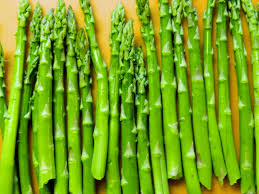Springtime Asparagus
by Cathe Olson
One of the things I love most about spring is…asparagus! That may sound strange but I am so nuts for grilled and roasted asparagus that I will eat it just about every day for the short time that local, organic asparagus is available and then dream about it the rest of the year.
While it’s the taste I love, asparagus is chock full of nutrients for your health. Asparagus is an excellent source of folic acid—in fact, a six ounce serving provides over 60% of the recommended daily allowance. Folic acid is necessary for blood cell formation, growth, and prevention of liver disease. It has been shown to play a significant role in the prevention of neural tube defects, so eat lots of asparagus if you’re pregnant or trying to conceive. Asparagus is also a good source of potassium, fiber, vitamin B6, vitamins A and C, and thiamin.
Asparagus grows best in sandy, well-drained soil. A well cared for plant will generally produce for about 15 years without being replanted. California, Washington, and Michigan are the largest producers. Asparagus is harvested in the spring into early summer.
Buy bright green, fresh-looking spears with compact tips. You will also want to choose spears of the same diameter for uniform cooking. Store asparagus in the refrigerator. If you’re not able to use it right away, stand the stalks upright in about 2 inches of cold water to keep them fresh.
Before cooking, rinse the asparagus spears well. Break off the tough ends (they will naturally snap where they become tender). Asparagus is delicious lightly steamed, stir-fried, sautéed, or in soup. Just be sure not to overcook it. Asparagus should be bright green and crisp. My absolute favorite, however, is grilled or roasted asparagus (recipe below). As a matter of fact, that’s the only way my kids will eat it. Roasted asparagus can be eaten hot or cold. It’s also great tossed with pasta, on sandwiches, or as a pizza topping.
For more asparagus information and recipes, check out www.asparagus.org.
Grilled or Roasted Asparagus
This works best with medium to fat spears. Skinny ones get too tough.
Toss asparagus spears with olive oil, salt, pepper, and just a splash of balsamic vinegar. Cook on a hot grill or roast on a baking sheet in a 375 degree oven 4 to 8 minutes per side (depending on the thickness of the spears). They should be browned and crisp on the outside but tender on the inside.
Asparagus Art
Here’s an idea to encourage hesitant children to try asparagus.
An asparagus stalk looks like a paintbrush. Put a dab of red ketchup, yellow mustard, and white mayonnaise on a plate. Let your children use asparagus spears (raw or lightly steamed) to paint pictures. When they’re done, they can eat their paintbrushes.
Spring Minestrone with Brown Rice
I find myself making this delicious soup from Super Natural Cooking by Heidi Swanson every week when I get my box of vegetables from the local CSA. It’s a great way to serve the thinner asparagus spears.
- 2 tablespoons extra-virgin olive oil
- 2 shallots, thinly sliced
- 1 clove garlic, minced
- 3/4 cup medium-grain brown basmati rice, rinsed
- 6 cups vegetable stock
- 1 cup sugar snap or snow peas, trimmed and cut in half diagonally
- 8 spears asparagus, trimmed and diagonally sliced into 1-inch pieces
- 1/2 cup green peas, fresh or frozen
- Fine-grain sea salt and freshly ground pepper
Heat the olive oil in a large saucepan over medium-high heat, then add the shallots and garlic and sauté for a couple of minutes until soft. Add the rice and cook, stirring for 1 minute, then add the stock and bring to a boil. Cover, lower the heat, and simmer until the rice is just tender, 35 to 45 minutes.
Add the sugar snap peas, asparagus, and green peas, and season with a few healthy pinches of salt and a few grinds of black pepper. Simmer for another 2 or 3 minutes and serve immediately; this way the vegetables stay crisp and bright.
Serves 4.
Recipe reprinted with permission from Super Natural Cooking: Five Ways to Incorporate Whole & Natural Ingredients Into Your Cooking by Heidi Swanson. Copyright 2007. Published by Celestial Arts.


